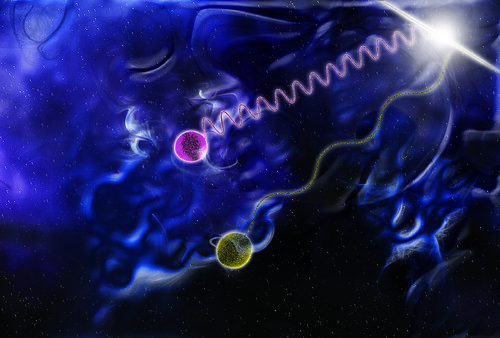
Two photons of different wavelengths.
Image courtesy of NASA/Sonoma State University/Aurore Simonnet.
From the forces of nature to the basic constituents of matter, the Standard Model explains everything we think we know about our world. For instance, matter arises from different configurations of two groups of fermions: quarks and leptons. Quarks are the particles that make up protons and neutrons, while leptons are stand-alone particles such as the electron. The Standard Model also tells us that there are four basic forces: the strong and weak nuclear forces, electromagnetism, and gravity. These forces operate by exchanging bosons such as the gluon, the W and Z particles, and the photon.
Bosons and fermions behave according to the laws of quantum field theory, the physics behind the Standard Model. Each has a property called "spin," which defines its intrinsic angular momentum in terms of a number. Bosons are only allowed to have spins that are integers, e.g., 0, 1, 2, 3. Fermions can only have half-integer spins, e.g., 1/2, 3/2, 5/2. In quantum field theory, this is called the Spin-Statistics Theorem. Another difference between the two lies in their configuration; namely, that no two fermions can occupy the same quantum state. This is why the electrons in an atom arrange themselves in separate shells around the nucleus. Bosons, however, can share a single quantum state. This is the phenomenon behind laser beams and Bose-Einstein condensation.
The idea behind the experiment at UC Berkeley was to try and violate the Spin-Statistics Theorem and thus disprove the distinctness of bosons and fermions. The scientists fired two lasers at a group of barium atoms in order to see whether any electrons in the barium would be excited to a higher energy level. The transition they were looking for occurs when two photons are absorbed at once, and is forbidden to bosons (like photons) by the Spin-Statistics Theorem. According to Damon English, a post-doc with the Berkeley group, if photons acted like fermions, the transition would "go like gang-busters." But it didn't. Not one two-photon absorption was observed. The researchers thus concluded that our understanding of the Spin-Statistics Theorem is sound. "Photons are bosons," claimed English, "at least within our experimental sensitivity."
No comments:
Post a Comment